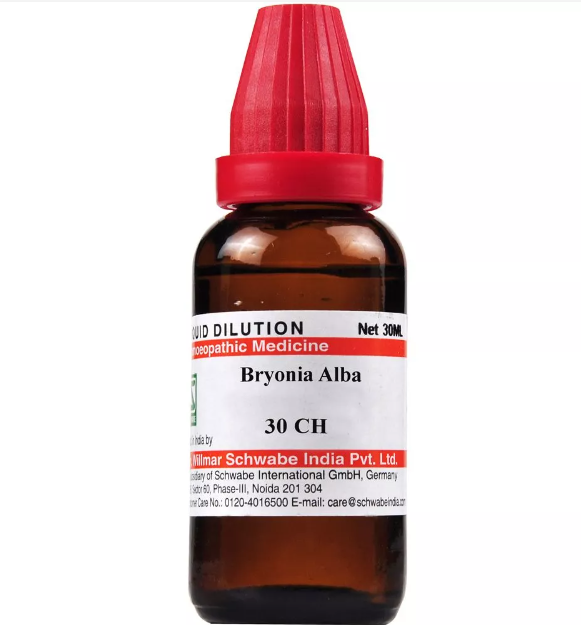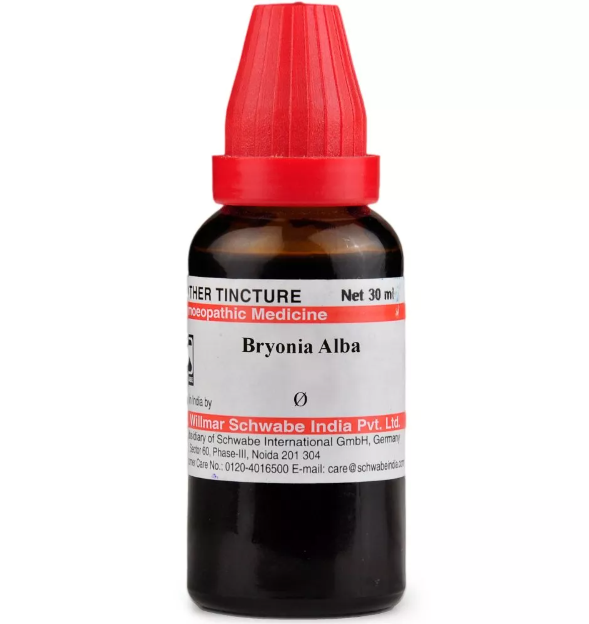BRYONIA ALBA Q, 6C, 12C, 30C, 200C, 1M, 10M USES AND SYMPTOMS
 Bryonia alba, commonly known as Wild Hops, is a potent remedy that acts on all serous membranes and the viscera they contain. Its characteristic pains are stitching and tearing, worsened by motion but relieved by rest. These pains are prominently felt in the chest and are aggravated by pressure. Mucous membranes throughout the body tend to be dry, and patients often experience a range of symptoms including irritability, vertigo upon raising the head, pressive headaches, dry and parched lips, excessive thirst, and bitter taste in the mouth.
Bryonia alba, commonly known as Wild Hops, is a potent remedy that acts on all serous membranes and the viscera they contain. Its characteristic pains are stitching and tearing, worsened by motion but relieved by rest. These pains are prominently felt in the chest and are aggravated by pressure. Mucous membranes throughout the body tend to be dry, and patients often experience a range of symptoms including irritability, vertigo upon raising the head, pressive headaches, dry and parched lips, excessive thirst, and bitter taste in the mouth.
Physically, Bryonia affects individuals of robust constitution, firm fiber, and dark complexion, particularly those prone to leanness and irritability. It has a preference for the right side, evening, open air, and warm weather following cold days for maximum manifestation of its effects.
Children who require Bryonia dislike being carried or raised, and the remedy is indicated for complaints that tend to develop slowly.
Mind: The Bryonia patient is exceedingly irritable, with everything putting them out of humor. They may experience delirium, expressing a desire to go home or talk about business matters.
Head: Vertigo, nausea, and faintness upon rising, accompanied by confusion. Headaches are bursting and splitting, as if everything would be pressed out, or as if hit by a hammer from within. These headaches worsen with motion, stooping, and opening the eyes, and may be accompanied by drawing pains in the bones towards the zygoma. Frontal sinus involvement may lead to frontal headaches.
Eyes: Bryonia patients may experience pressing, crushing, or aching pain in the eyes, which are sore to touch and when moving.
Ears: Symptoms may include aural vertigo and sensations of roaring or buzzing in the ears.
Nose: Bryonia patients may suffer from frequent epistaxis, especially when menses should appear. Coryza may accompany shooting and aching in the forehead, and there may be swelling of the tip of the nose, feeling as if it would ulcerate when touched.
Mouth: Bryonia causes dryness of the mouth, tongue, and throat, accompanied by excessive thirst and a bitter taste. Lips become parched, dry, cracked, and may even swell, becoming dry, black, and cracked in chronic smokers.
Throat: Dryness, sticking pain on swallowing, and a scraped and constricted sensation may be felt in the throat. Tough mucus may be present in the larynx and trachea, loosened only after much hawking, and worsened upon entering a warm room.
Stomach: Bryonia is indicated for individuals experiencing a range of stomach-related issues. Patients typically exhibit symptoms such as nausea and faintness upon rising, abnormal hunger accompanied by loss of taste, excessive thirst, and vomiting of bile and water after meals. There may be a sensation of pressure in the stomach after eating, as if a stone were present, along with soreness exacerbated by coughing. Dyspeptic ailments, especially during summer heat, are also common.
Abdomen: Symptoms in the abdomen may include swelling and soreness in the liver region, burning pain, stitches, and tenderness of the abdominal walls.
Stool: Constipation is common, with stools being hard, dry, and seemingly too large. Stools may be brown, thick, and possibly bloody, with aggravation in the morning, from movement, and in hot weather.
Urinary: Urine may be red or brown, resembling beer, and may be scanty and hot.
Female: Menstrual symptoms associated with Bryonia often include early or profuse menses, exacerbated by motion and accompanied by tearing pains in the legs. Suppressed menstruation may lead to severe headaches or vicarious discharges. Ovarian pains are marked by stitching sensations exacerbated by deep inspiration, with extreme sensitivity to touch. Right-sided ovarian pain extending to the thigh may be present, along with tenderness and inflammation of the breasts, possibly leading to mastitis or abscess formation. Bryonia is also indicated in cases of intermenstrual pain accompanied by abdominal and pelvic soreness.
Respiratory: Bryonia is indicated in cases of dry, hacking cough, particularly when irritation is felt in the upper trachea. The cough is often worse at night, after eating or drinking, and may lead to vomiting. Expectoration of rust-colored sputum or tough mucus is common. Patients may experience a sensation as if the chest would fly to pieces, necessitating support to the chest. Pleuritic pain and pleurisy stitches in the chest accompany the cough, leading to a sensation of heaviness beneath the sternum, often extending towards the right shoulder. Bryonia is particularly useful in cases of pleuritic pain, where any movement exacerbates the discomfort. Patients may feel the need to expand their lungs or take deep breaths to alleviate the pain. Pneumonia and respiratory infections in cases of croupous and pleuro-pneumonia, Bryonia may be indicated, especially when symptoms include coughing fits, difficulty breathing, and expectoration of tough mucus. The cough is worsened by entering a warm room and may be accompanied by angina pectoris.
Back: Bryonia induces stiffness and pain in the back, particularly in the nape of the neck and lumbar region. These symptoms are exacerbated by sudden changes in weather and exposure to hard water.
Extremities: Bryonia is effective for addressing various issues affecting the extremities, particularly the knees, which may exhibit stiffness and pain, indicative of arthritis. Hot swelling of the feet, along with red, swollen, and painful joints exacerbated by movement, are common manifestations. Additionally, constant motion of the left arm and leg may be observed.
Sleep: Bryonia patients may feel drowsy, with starting upon falling asleep and delirium focused on business matters and what they have read.
Fever: In cases of fever, Bryonia is indicated when there is a full, hard, tense, and quick pulse, accompanied by chills and external coldness. Dry cough with stitches, internal heat, and sour sweat after slight exertion are typical symptoms. Profuse perspiration and rheumatic fever or typhoid with gastro-hepatic complications.
Skin: Skin symptoms may include yellow, pale, swollen, and dropsical skin, which is hot and painful, along with seborrhea and excessively greasy hair.
Modalities: Symptoms worsen with warmth, any motion, in the morning, after eating, in hot weather, and with exertion, but improve with lying on the painful side, pressure, rest, and cold things.
Relationships: Complementary to Upas when it fails, and it may be compared to remedies like Rhus tox and Alumina. Additionally, Illecebrum verticillatum, a Mexican drug, shares similarities with Bryonia in fever and typhoid symptoms.
When considering antidotes, Aconite, Chamomilla, and Nux vomica are indicated. Other remedies to consider in comparison include Asclepias tuberosa, Tuberculinum, Kali muriaticum, and Ptelea.
dose: First to twelfth attenuation.
SYMPTOMS OF BRYONIA ALBA
Mind: Highly irritable; easily angered. Delirium with a desire to return home and focus on business matters.
Head: Vertigo, nausea, and faintness on rising. Headache feels bursting, splitting, worse from motion, stooping, and opening the eyes. Pain may extend from the occiput to the zygoma.
Eyes: Painful, sore to touch, and sensitive when moving.
Ears: Aural vertigo, roaring, buzzing.
Nose: Epistaxis, especially when menses should appear. Coryza with shooting and aching in the forehead. Tip of the nose swollen and tender.
Mouth: Lips parched, dry, cracked. Excessive thirst, bitter taste, burning sensation.
Throat: Dryness, sticking pain on swallowing, constricted feeling. Tough mucus, worse in warm rooms.
Stomach: Nausea, faintness, abnormal hunger, and excessive thirst. Vomiting of bile and water after eating. Sensitivity to touch in the epigastrium.
Abdomen: Liver region swollen, sore, burning pain. Tenderness of abdominal walls.
Stool: Constipation, hard, dry stools, brown, thick, possibly bloody. Worse in the morning, from motion, hot weather, and cold drinks.
Urinary: Red, brown urine, scanty, hot.
Female: Menstrual irregularities, early, profuse menses, with tearing pains in the legs. Painful, sensitive ovaries.
Respiratory: Soreness in larynx and trachea, hoarseness. Dry, hacking cough worse at night, after eating or drinking. Difficulty breathing, stitches in the chest.
Back: Stiffness, stitches in the nape of neck, lumbar region.
Extremities: Painful, stiff knees, hot swelling of feet. Red, swollen, hot joints, worse with movement.
Sleep: Drowsiness, starting when falling asleep. Delirium about business matters.
Fever: Full, hard pulse, chills with external coldness, internal heat. Sour sweat, easy perspiration. Rheumatic fever, typhoid with gastro-hepatic complications.
Skin: Yellow, pale, swollen, dropsical. Seborrhea, greasy hair.
Modalities: Worse warmth, motion, morning, eating, hot weather. Better lying on painful side, pressure, rest, cold things.
Relationship: Complementary: Upa when Bryonia fails. Antidotes: Acon., Cham., Nux-v.
selection of the potency
Individualization:
- Homeopathy is based on the principle of treating the individual, not just the disease. The unique symptoms and characteristics of the person are crucial in determining the most suitable potency.
Intensity of Symptoms:
- The intensity of the symptoms guides the choice of potency. If the symptoms are intense and acute, a lower potency (e.g., 6C, 30C) might be considered. For chronic conditions with less intensity, higher potencies (e.g., 200C, 1M) may be appropriate.
Sensitivity of the Patient:
- Some individuals are more sensitive to homeopathic remedies, while others may require higher potencies. The practitioner considers the patient’s sensitivity when selecting the potency.
Acute vs. Chronic Conditions:
- Lower potencies are often used for acute conditions, while higher potencies may be considered for chronic or long-standing issues.
Previous Response to Potencies:
- The patient’s response to previous homeopathic treatments helps guide the choice of potency. If a particular potency has been effective in the past, it may be repeated or adjusted as needed.
Vital Force and Susceptibility:
- Homeopathy views illness as a disturbance in the vital force. The practitioner assesses the patient’s overall vitality and susceptibility to determine the appropriate potency.
Aggravation or Amelioration:
- The direction of the symptom response (aggravation or amelioration) after taking a remedy can influence the choice of potency.
Miasmatic Considerations:
- In classical homeopathy, the concept of miasms (inherited disease tendencies) is considered. The practitioner take this into account when selecting the potency.
Practitioner Experience:
- The experience and preference of the homeopathic practitioner play a role. Some practitioners may have success with certain potencies based on their clinical experience.
SAFETY INFORMATION
- Do not exceed the recommended dose by physician
- Keep out of the reach of children
- Store in a cool dry place away from direct sunlight
- Maintain half an hour gap between food/drink/any other medicines and homoeopathic medicine
- Avoid any strong smell in the mouth while taking medicine e.g. camphor, garlic, onion, coffee, hing
Medicine images use for reference only selection of homeopathic medicine depends on the individual’s specific symptoms and overall constitution. Moreover, homeopathy is a holistic system of medicine that treats the individual as a whole. In addition to addressing the physical symptoms, it takes into account the emotional and mental state of the person. Consequently, it’s crucial to consult with a qualified homeopathic practitioner for personalized treatment.
The information provided on this website is intended solely for educational purposes. Always seek the advice of your physician or other qualified health provider.
